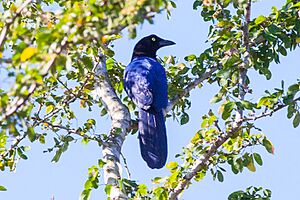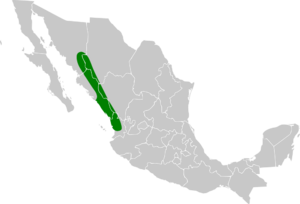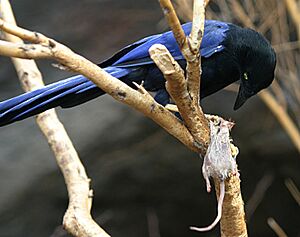Purplish-backed jay facts for kids
Quick facts for kids Purplish-backed jay |
|
|---|---|
 |
|
| In Sinaloa, Mexico | |
| Conservation status | |
| Scientific classification | |
| Genus: |
Cyanocorax
|
| Species: |
beecheii
|
 |
|
The purplish-backed jay (Cyanocorax beecheii) is a colorful bird. It belongs to the crow family, called Corvidae. This bird has beautiful purple feathers on its back, wings, and tail. The rest of its body is black.
You can only find this jay in northwestern Mexico. It lives mainly in dry forests where trees lose their leaves. Experts at the International Union for Conservation of Nature say it is a "species of least concern". This means it is not currently in danger of disappearing.
Contents
What Does the Purplish-Backed Jay Look Like?
The purplish-backed jay is a striking bird. It has a mix of purple and black colors. This bird also has a strong black beak and a long tail.
It can be about 35 to 41 centimeters (14 to 16 inches) long. Male jays are usually a bit bigger than females. Its head, neck, and belly are black. It has a small, fluffy crest of feathers on its forehead. The feathers under its wings and on its tail are also black.
The rest of its body is a bright purplish-blue. This color is brightest on its lower back. Its eyes and legs are yellow, which stands out against its dark feathers.
How Purplish-Backed Jays Live

These jays live in small family groups. A group usually has a grown-up pair and up to three young birds. These young birds are from the year before.
They move through the forest looking for food. They eat small animals without backbones, like insects. They also eat small animals with backbones. Some insects are caught while flying. Others are picked off leaves. They find grubs by poking their beaks into tree bark. They also search for food in fallen leaves on the ground.
Purplish-backed jays are omnivores. This means they eat both plants and animals. Sometimes, they leave the forest to find food. They might visit fruit farms or fields of grain. They also look for food at trash dumps and along roads.
Home and Family Life
These bird groups have their own special areas, called territories. Their territory can be about 25 to 43 hectares (62 to 106 acres) big. They protect their home from other jay groups. They also work together to scare away predators.
Purplish-backed jays stay with the same partner for their whole lives. They show their bond in many ways. They make special calls and preen each other's feathers. They also pass food to one another.
Even if a group has more than one pair, usually only the main pair will have babies. The female builds the nest with help from other group members. The nest is a messy platform made of twigs.
Reproduction and Young Birds
The female usually lays about five eggs in early May. She sits on the eggs for about 19 days to keep them warm. During this time, the male feeds her. Sometimes, other group members help feed her too.
When the chicks hatch, both parents feed them. Other group members also help feed the new babies. The young birds are ready to fly, or fledge, in about 24 days. Young males usually stay with the group for about a year. Then they leave to find their own territory. Young females might stay with their family group forever.
Conservation Status
The number of purplish-backed jays is slowly going down. This is because the dry forests where they live are shrinking. However, this decline is happening slowly. Also, the birds live across a wide area. Because of this, the International Union for Conservation of Nature says the purplish-backed jay is a "species of least concern". This means they are not in immediate danger.


